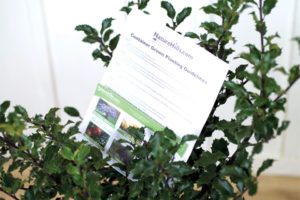How You Can Tackle Online Plant Sales

Peony’s Envy ships peony bulbs and peony-related products. Photo credit: Peony’s Envy
Most consumers are spending anywhere between five to 10 hours a day using their smartphones, depending on which new study you read. And at least a portion of that time is spent either researching new products or buying something.
While selling plants online isn’t as common as selling products like books or new high-tech devices, it is certainly an expanding segment of the market. If you’re not selling your product online, odds are you will be in the near future.
So what do you need to know if you’re looking to tap into this market? We checked in with a number of companies that are active players online, and asked them about the major issues they deal with. Here’s what they had to say.
1. The Demand for Buying Plants Online Will Only Increase
Buying and selling plants online isn’t new, but as consumer expectations evolve, the horticulture industry needs to keep up.
“The expectation is becoming that consumers should be able to buy every product or service online,” says Sid Raisch, CEO of Bower & Branch, a Leesport, PA-based group of independent, family owned growers and garden retailers. “We are finding that we are absolutely not ahead of the consumer market, and in fact, we’re chasing it and missing opportunities where we are not already operating. But we’ll catch up, and quickly.”
Bower & Branch has positioned itself as a services solution that helps grower members get to market faster and more affordably, while providing a visible online solution that is optimized for search engines and rich with features consumers expect.
“What we’ve done is to build the way for our member independents to be found by consumers who are looking for what we’re putting online on their behalf,” Raisch says. “We enable our members to capture sales opportunities for things people are looking for that are otherwise lost to the endless list of items they cannot bring in or run out of.”
It is this commitment to helping growers navigate online plant sales that led Jim Eason, founder of Eason Horticultural Resources (EHR), to join the Bower & Branch board of directors.
“Our company deals directly with growers and retailers via online ordering for a wide range of products ranging in size from unrooted cuttings to large woody and tropical plants,” Eason says. “Our company’s involvement with Bower & Branch is a result of recognizing that the future well-being and success of our customers and suppliers will be maximized through the technology and logistics available through this company that is consumer facing.”
Nurseries experienced in online sales will also tell you that sales are booming.
“The demand for plants online is definitely growing, and we have experienced double-digit sales growth every year for the past five years,” says Jeff Dinslage, President of Omaha, NE-based Nature Hills Nursery, an online-only retailer of plants that bills itself as America’s largest online plant nursery. “As consumers become more familiar with online shopping, they are making more purchases online of virtually every category of product. Clearly, that includes shopping for plants.”
The same is true for Monrovia Nursery, which allows consumers to buy plants online that are then shipped to local independent garden centers.
“We have seen a 200% increase in online sales from 2016 to 2017, and we expect demand to keep increasing for the foreseeable future,” says Bryan Hughes, E-Commerce Sales Manager at Monrovia.
2. Provide as Much Detail About Your Plants as Possible
Buying online means consumers have to do a little more homework, according to Hughes.
“Because they can’t touch, feel, or size up the plant they’re looking for, they need to be absolutely sure that the plant they’re ordering will work for them,” Hughes says. “Having a lot of great information on every variety we sell has helped us make consumers feel confident about their purchases.”
Because online shoppers are often strapped for time, we must give them all the information they need in an easy, digestible format, says Stacey Noble, a Retail Business Manager for Ball Horticultural Company who works with growers to help them sell online.
“People that dwell in urban or rural areas may not have as easy of access to gardening products,” Noble says. “Online garden shopping gives them access to a broad array of plants that they may not have had access to previously.”
Noble says that getting our product in front of consumers, where they shop, is one of the main reasons to learn how to sell plants online.
“If we are not showing them our product when they’re ready to buy, we may lose them,” she says. “Just like at a retail store, it is important to create a positive buying experience for online purchasers.”
A great example of this is the website for White’s Flower Farm in Litchfield, CT. White’s sells almost exclusively online, and its site includes shopping guides for both plant categories and accessories, detailed photos, and information on hardiness zones and plant care.

‘Blue Princess’ Holly from Nature Hills Nursery. Photo credit: Nature Hills
3. Online Sales Can Help You Tap Into Hot New Plant Categories
Succulents, tropicals, shrubs, and houseplants such as orchids are among the most popular plants sold online. However, what is more pertinent, according to Eason, is that consumers want to have an expanded selection of plants and services available to them online — not just what a particular grower has on their availability at a point in time or what the limited online offering may be from the retailer.
“Our vision is to expand the consumer’s buying options by having more items that the consumer is actually looking for than is possible or affordable in a store inventory,” Eason says. “Providing sales opportunities for a wider range of plants 365 days a year, regardless of the season or weather, can open up all sorts of opportunity.
Raisch notes that a majority of online purchases begin with search, which means that what consumers buy is very much in alignment with what they buy in stores.
“The part that is missing is that many consumers buy what’s available, not what they wanted in the first place,” Raisch says. “Missed selling opportunities is the invisible number in retail. Sometimes this is a better choice of plant for their situation, and sometimes it is a matter of convenience, and not one of fulfilled desire.”
4. Inventory Management is Critical
According to Eason, growers must maintain a more sophisticated inventory management system when they are selling online, whether it’s to wholesale customers or direct to consumers. This includes projecting future availability dates, as well as forecasting future inventory demand.
Raisch echoes these sentiments.
“The consequence of allowing a consumer to buy online and then not having the inventory are the same as allowing a wholesale customer to order online and then not supplying the product they expect,” Raisch says. “We simply do not sell what we cannot actually provide in terms of both quantity and quality, which is even more critical.”
The key to success in online sales is communication, says Dinslage, and that includes communication with growers and fulfillment centers.
“NatureHills.com operates on a real-time inventory basis, so communication is the key to knowing if a plant is ready to sell” Dinslage says. “We need to know if there are any issues with specific skus of plants, such as the health of the plants or whether the plants can handle the shipping process in cold or unfavorable weather conditions. If so, we immediately stop selling those plants online.”
Dinslage also says forecasting inventory needs for the upcoming year is crucially important.
“Having too many plants in stock is a problem, just as having too few is a problem,” he says. “We use historical information to help us plan for demand, and we also factor in the marketing plan for each category of plants that we sell.”
5. Shipping Concerns Need to Be Addressed
The increased popularity of e-commerce sales has greatly increased the package count that carriers are dealing with, and that has stressed the entire distribution system, Dinslage says. In addition, while anyone can put a plant in a box and ship it, that doesn’t mean the plant will arrive at the customer’s door in good condition.
Dinslage says NatureHills.com has developed proprietary packaging to ensure the plants it ships arrive in excellent condition.
“The standard corrugated box doesn’t work anymore, because of the rigors of shipping to today’s delivery environment,” Dinslage says. “Our boxing is designed to get 100% of plants shipped successfully. The boxes and the packaging inside the boxes have to be engineered to protect the plants or our customers are not going to be satisfied.”
Another company that specializes in online plant sales is Peony’s Envy, based in Bernardsville, NJ. Peony’s Envy turned to online sales in 2006, and while owner Kathleen Gagan says her company ships bulbs as opposed to live plants, the challenges of shipping are consistent.
“The economics of being able to ship something in leaf in an affordable way, and not having it damaged while going through the mail system, is a challenge,” Gagan says. “The cost of shipping is a top priority, whether you’re sending a truck of plants or individual plants. If you sell online, you’re likely to have smaller quantities, so how do you handle shipping and handling fees?”
Concerns about effective shipping are one reason online sales of succulents and tropicals have increased, Noble says.
“These products typically hold well at the grower level and are easier to ship, allowing for a good out-of-box experience for the consumer,” Noble says, while noting that plants must arrive at the consumer’s door with a great out-of-the-box experience.
In terms of timing, Eason says that having access to a sophisticated specialized delivery system for perishable plants is a very important option to have.
“The general consensus is that consumers want everything shipped immediately,” Eason says. “However, when it comes to shipping green goods and providing any associated services, this is not necessarily the case, especially if the consumer wishes to pick up at the store.”
6. Decide Whether You Want to Ship Direct to Consumers or Offer In-Store Pickup
The growers that are currently selling plants online are taking different approaches, from using their own websites to using Amazon (see “The Latest on What’s Happening at Amazon” sidebar) to using specialized services such as Bower & Branch.
“The majority of growers are selling to brick-and-mortar stores, and since few garden retailers sell plants online, they have to know they are not reaching that expanding online market, if they acknowledge that it really exists,” Eason says.
Whichever direction they take, Eason says it’s important to note that growers will always want to have a good network of high-quality brick and mortar retailers that participate with them to offer the consumer the ability to pick the product up in the store, as well as being shipped direct to the consumer. In other words, keep both of these options open.
In the past few years, Monrovia has built a successful system of working with its customers.
“In our first year, we didn’t know what to expect in terms of demand for online plant purchases,” Hughes says. “Now we know that growers need to set aside some of their stock to supply the online store. We ship orders to garden centers that are already in our customer base, which makes it possible for us to deliver plants almost year-round so they are delivered when they’re looking their best.”
7. Say Yes to Online Sales, But Don’t Ignore Your Current Customers
Kathleen Gagan, who has built a strong personal connection with her customers at Peony’s Envy, says online sales are certainly where things are headed, and everyone needs to learn to do it.
“But at the same time, don’t lose track of how important a personal relationship is to your customers,” Gagan says. “You can keep it personal even if the relationship is mainly online.”
The bottom line, Gagan says, is not to undermine a proven sales model you already have established.
“Don’t move away from something that is familiar and works,” she says.
Online Plant Sales Don’t Have to Be DIY
There is currently a mix of growers selling online themselves, or working through a third party. Some growers have an online platform for their own company, and some are supplying directly to retailers that they currently work with because the retailers are asking to get as many SKUs online as possible.
Jim Eason of Eason Horticultural Resources recommends partnering with someone who has proven the ability to attract buyers to their site, specifically in the green goods space.
“Bower & Branch provides an online platform that enables members to capture sales opportunities for things that people are looking for that normally would be lost because they couldn’t afford to stock all of them or were simply out of stock,” Eason says.









